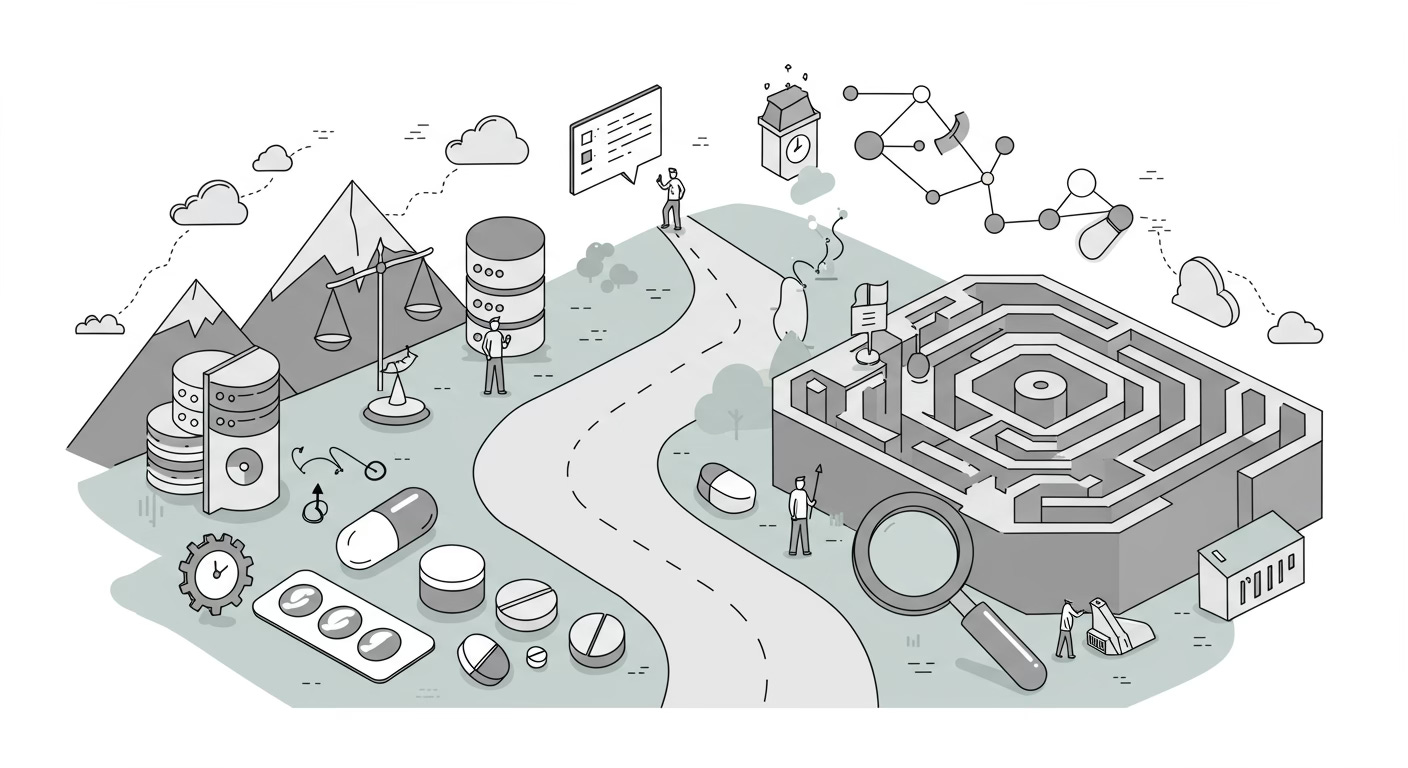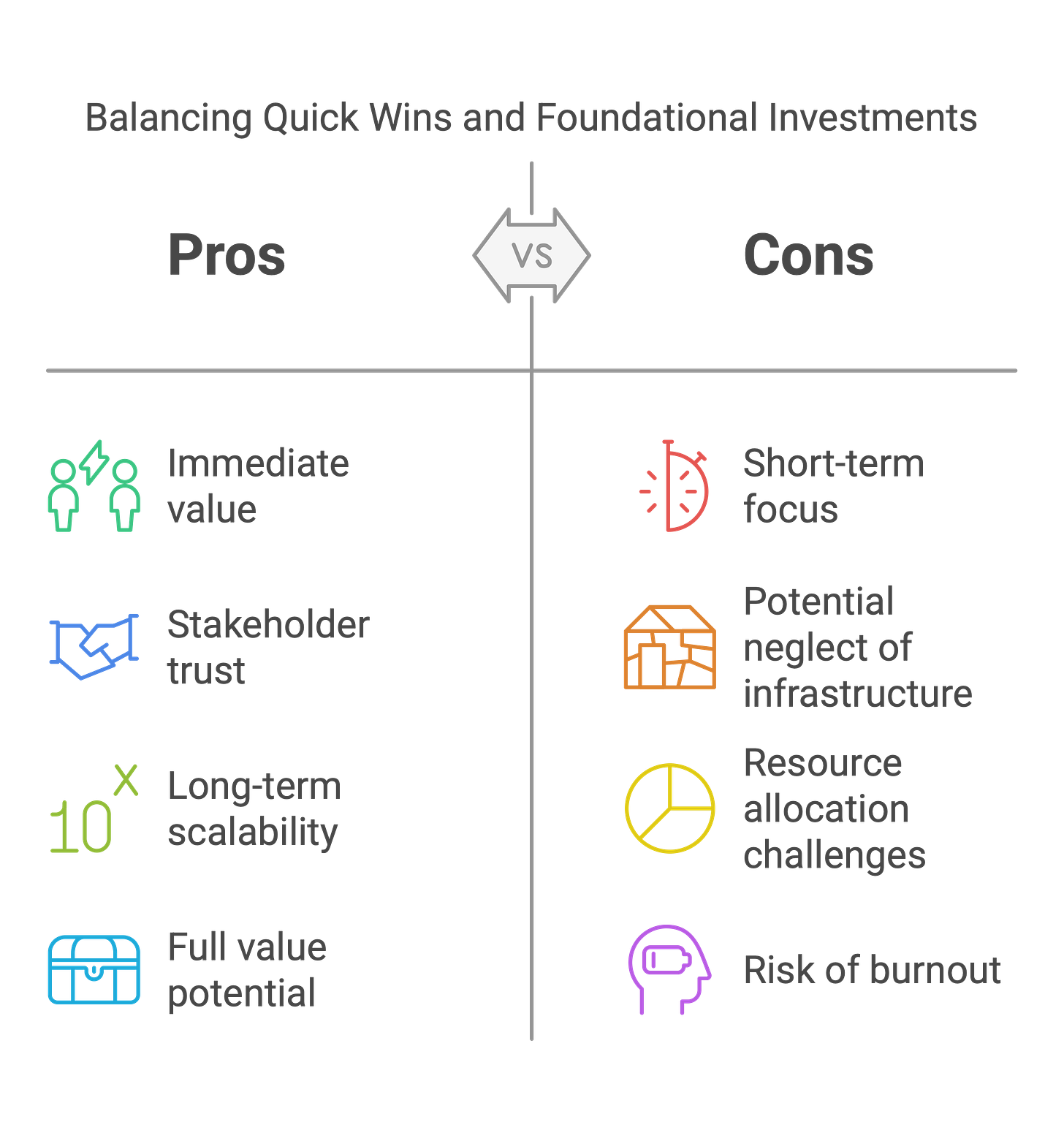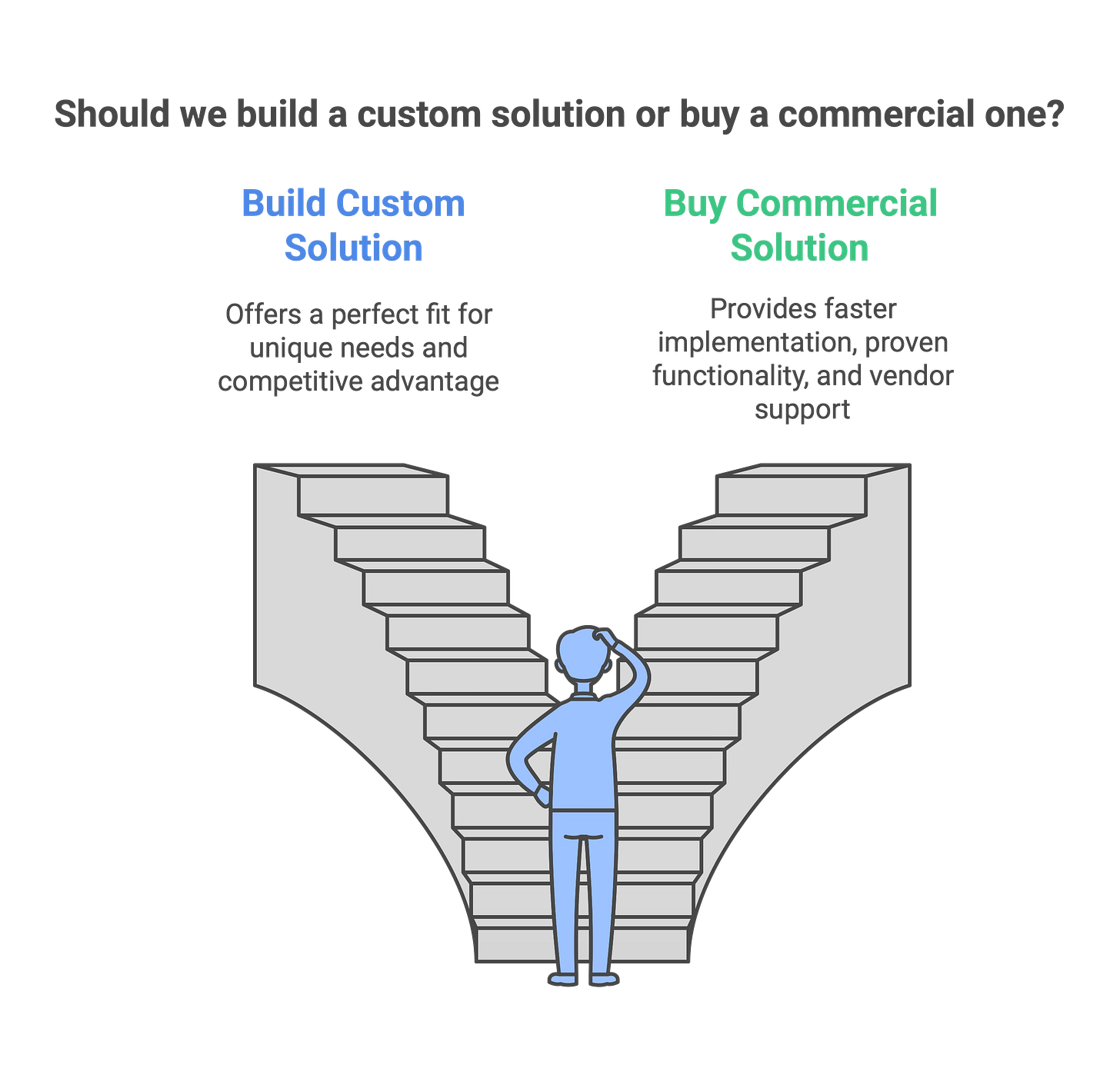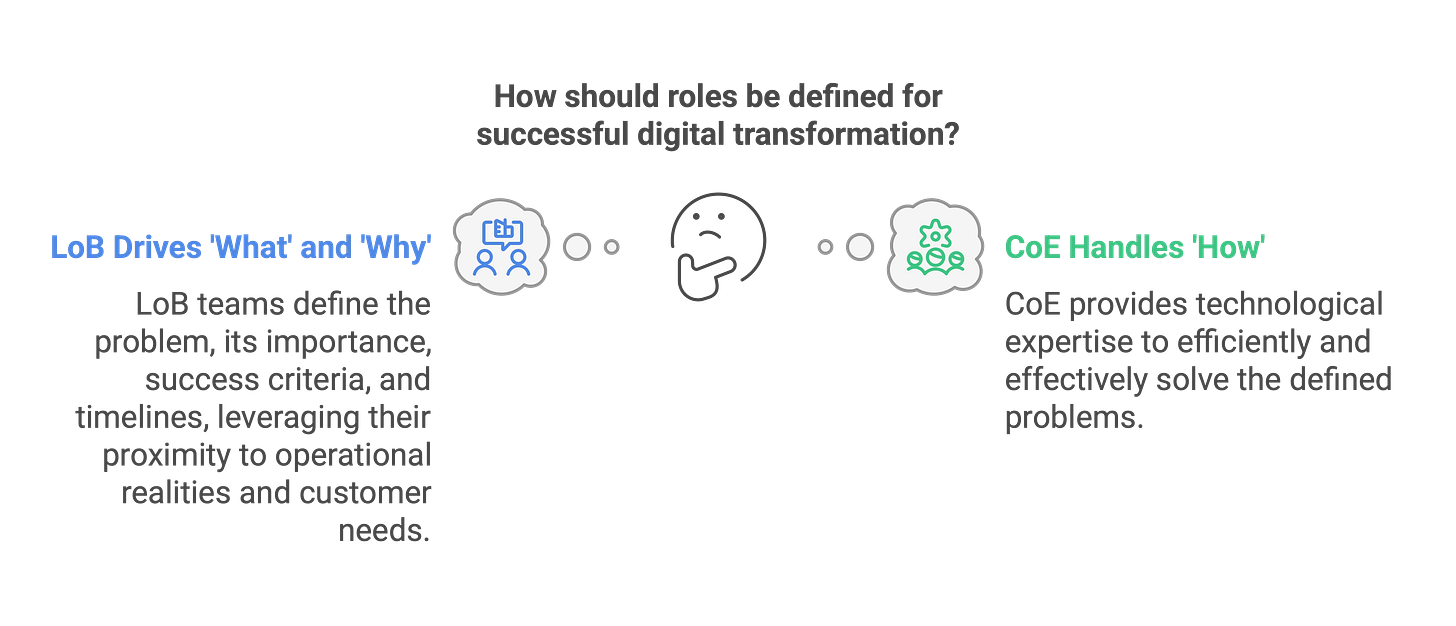Navigating Digital/Data/AI Transformations in Pharma: 5 Lessons from my journey up until now
Insights from Over 7 Years of driving it in Big Pharma
Digital/Data/AI (choose your preferred moniker :)) transformations in the pharmaceutical industry is a journey fraught with challenges, opportunities, and hard-earned lessons. Having being part of leading the formation and scale up the Digital Health franchise in a big pharma and shaped and influenced the digital strategy for Global Drug Discovery in Research & Early Development in the same company, I've experienced firsthand the complexities and difficulties of driving meaningful change in a large organization.
Interestingly the underlying challenges that prevent the realisation of value are not very different whether driving digital transformation in the end-consumer (read: patient) space vs the drug discovery space which is more internally focused digital transformation.
Below, I share key insights from my journey, focusing on aligning technology with business needs, balancing innovation with practicality, and addressing common pitfalls. I do this also because I ok yet another one of these journeys as ai write this.
1. Start with the Problem, Not the Technology
In my experience, one of the biggest challenges in digital transformation is the tendency to prioritize "shiny new things" over solving real business problems. Stakeholders often push for cutting-edge technologies—currently we are seeing a lot of use of Large Language Models (LLMs)—without fully understanding the underlying requirements or limitations or even the value benefit vs other approaches.
For example, I've encountered situations such as the following: "Can't we just use LLMs on our vast datasets to generate new insights?" While technically “easy”, this overlooks critical “hard” issues that will prevent actual value realisation that I have see repeating across enterprises :
Data Infrastructure Gaps: lack the foundational data infrastructure needed to support such initiatives - (note: it’s difficult, unsexy without shiny-and-new appeal, employee intensive, expensive and time consuming to do)
Data Quality and Compliance: Trial and experiment data may be incomplete, unstructured, or subject to GDPR or other requirement preventing use due to e.g. how data was collected, and other regulatory constraints.
Operational Readiness: Without proper preparation, projects often result in flashy demos that work only in controlled environments but fail to scale.
My Observation:
Digital transformation efforts must start with clearly defined business problems (defined by the business/LoB). Technology should be a means to an end—not the end itself. When I've seen this principle applied effectively, it has ensured that initiatives are grounded in practical value rather than hype and it will have staying power.
2. Balance Quick Wins with Long-Term Foundations
There's often a tension between delivering quick wins to demonstrate progress and investing in foundational work that enables scalability and realization of the value potential, and “quick wins” often wins more than what is helpful. Both are important, but they need to be balanced carefully and in my experience the force of gravity leans towards emphasising quick wins too often which leads to failure over time. Without the foundational work, you risk getting stuck with solutions that indicate potential but fail to realize the full value of the use case and ultimate this kills efforts that shouldn’t have been killed. The problem is just that foundational work is very unsexy, complex, expensive and time consuming, so it’s a hard sell to stakeholders, who will look at what e.g. is being announced by other companies (who might be looking for funding or reassuring investors that they are on the “hype-train” not being left behind) and/or being sold by external vendors/consultants looking for new business.
The balance that needs to be struck:
Quick Wins: Delivering small, impactful projects that showcase immediate value (e.g., automating repetitive tasks or improving reporting dashboards) does help build stakeholder trust early in a project and continous trust over time.
Foundational Investments: At the same time, investing in robust data infrastructure, technical foundation and governance frameworks has been crucial for enabling long-term scalability and unlocking the full value potential of digital initiatives.
Example Framework:
Finding the balance is critical in maintaining momentum while ensuring that solutions don't fall apart when scaled across larger teams or geographies, and can fully deliver on their promised value. The hard part is not the trust building, but getting buy-in to do the expensive time consuming foundational work needed.
3. The Buy vs. Build Dilemma
Another recurring challenge I have consistently seen is deciding (well, agreeing) whether to build custom solutions internally or buy commercially available ones. In my experience, Digital CoEs often lean toward building bespoke solutions to create a “perfect fit” for the purpose.
However, I've found that buying and adapting existing solutions is typically more effective—especially when internal capacity is constrained, which I have found to be the case most often. In a large company there is always the opportunity cost to investing people in building the future vs supporting the now.
Why I Often Favor 'Buy' as an in-going hypothesis:
Frees up internal resources for strategic tasks (getting enough people working on something quickly enough is often one of the main issues)
Often you can get >90% of the value capture with a commercially available solution you adjust, which is enough
Faster implementation
Proven functionality
Dedicated vendor support for operations, bug fixing etc
Continous development of solution which is shared with all the other customers of the vendor, also when the “next new shiny thing” is in focus internally and require resources internally move towards whatever that is
That said, there are rare cases where building makes sense—such as when a solution provides a critical competitive advantage or addresses a unique need specific to the company, but this is rarity and often the commercial available solutions can be adapted to account for specific needs to a degree that is satisfactory.
4. Empower LoB Ownership with CoE Support
One of my key learnings is that successful digital transformation requires clear delineation of roles between Line of Business (LoB) and Digital CoEs.
LoB must own the problem definition and success criteria, while CoEs should focus on enabling solutions through technical expertise.
What have I seen has worked?
LoB Drives the 'What' and 'Why': LoB teams are closest to operational realities and customer needs. They must define what needs to be solved, why it's important, what constitutes success, and when results are needed.
CoE Handles the 'How': The CoE brings technological expertise to bear on solving these problems efficiently and effectively.
For example:
LoB might define a goal like "Accelerate drug candidate identification by 30% for our pipeline within the next 24 months."
They also articulate success criteria: "Increase the number of viable drug candidates entering preclinical testing by 25% without increasing research costs."
The CoE then evaluates potential solutions—such as AI-powered molecule screening platforms or advanced computational modeling tools—and works collaboratively with LoB to implement them.
In my experience, this division of responsibilities ensures alignment while giving both teams the freedom to focus on their strengths, but it is often difficult to agree on in a matrix organisation as many people are more motivated by the why and what than the how and LoB. How is associated with “support” / “enablement” which many are not comfortable with being boxed into.
5. Manage Stakeholder Expectations Through Alignment
Unrealistic expectations from stakeholders is a common challenge—but they're often also warranted for other reasons. In my experience, these expectations typically stem from a genuine need within LoB or other stakeholders to solve pressing business problems within specific timelines. If these timelines aren't met, stakeholders may believe that solving these problems will no longer be relevant or impactful.
For example:
Stakeholders might say these days: "Can't we just use LLMs (or another hot technology) to solve this problem now?" While this reflects real business pressures, it can lead to misalignment if not addressed properly.
What I've Learned:
Alignment on expectations from the start is critical:
Clearly define what can realistically be achieved within given constraints (don’t forget to assess data quality, infrastructure readiness, regulatory compliance).
Be transparent about what cannot be done immediately—and why.
Establish mutual agreement on timelines for deliverables and milestones.
Create a shared understanding of what success looks like—not just in terms of technical delivery but also how it will impact business outcomes.
Ensure continuous and frequent involvement between LoB & CoEs (on both side of the fence, someone needs to wake up every morning thinking whatever they are jointly working on, is their main (>50% allocation of their time) priority. If e.g. LoB say something like “we can’t allocate that high an allocation”, you should investigate whether this is because the project isn’t of high enough priority (there are exceptions of course we some projects are less, but ask the question).
This alignment ensures that both LoB and CoE teams work toward shared goals without overpromising or underdelivering.
6. Discussion Questions
I’ll leave you with a couple of questions and would love to hear perspectives to nuance my own
Balancing Quick Wins and Foundational Work: How can organizations ensure that short-term successes don't overshadow the need for long-term foundational investments? What strategies have you seen work effectively in balancing these two priorities?
Buy vs. Build: In what scenarios do you believe building custom solutions is preferable to buying existing ones? How do you evaluate the cost-benefit analysis of each approach?
Stakeholder Alignment: What strategies have you found most effective for managing stakeholder expectations and ensuring alignment across different teams? How do you handle situations where stakeholders have unrealistic timelines or expectations?
Lessons from Failures: Reflecting on Novartis' Data42 initiative, what key takeaways can be applied to future projects? How can organizations avoid similar pitfalls in their own digital transformation journeys?
Future of Pharma Tech: As AI and other technologies continue to evolve, what do you see as the most promising areas for innovation in pharma? How can companies best position themselves to leverage these advancements?
Balancing Innovation and Practicality
Digital transformation isn't just about adopting new technologies—it's about solving real problems with precision at scale using new technologies. My experience has shown me that success lies in balancing quick wins with foundational work, empowering LoB ownership while leveraging CoE expertise, managing stakeholder expectations transparently, and learning from both successes and failures along the way.
As LLMs (currently) and other cutting-edge tools and technology continue dominating discussions, it's vital to remember that true success comes not from adopting the latest tech but from delivering solutions that drive tangible value for patients, researchers, and stakeholders alike, and following through on the change journey for all people involved who has to change their behvior to make it happen.







